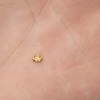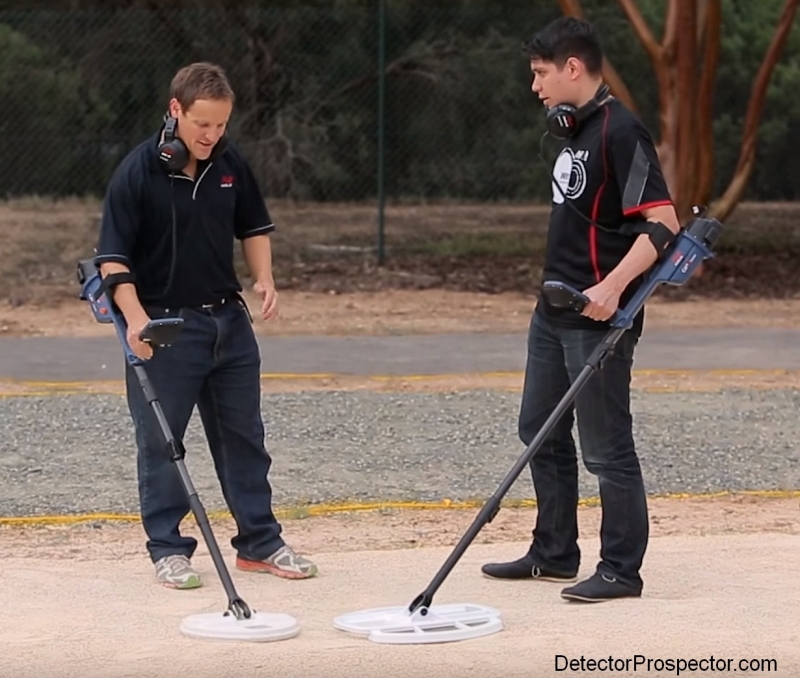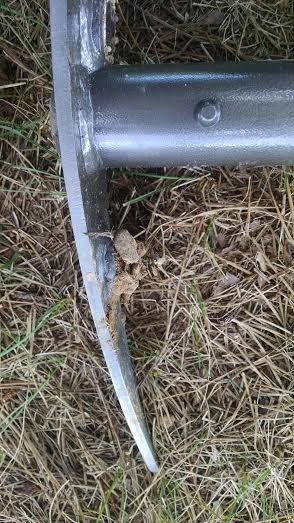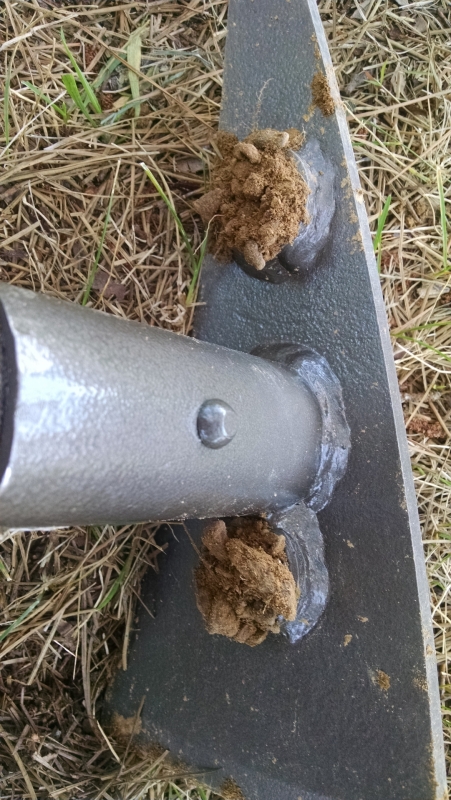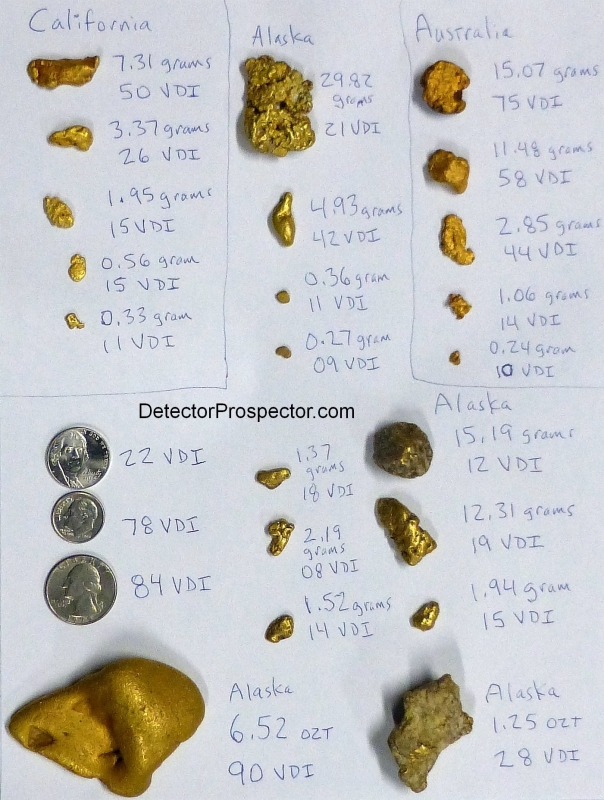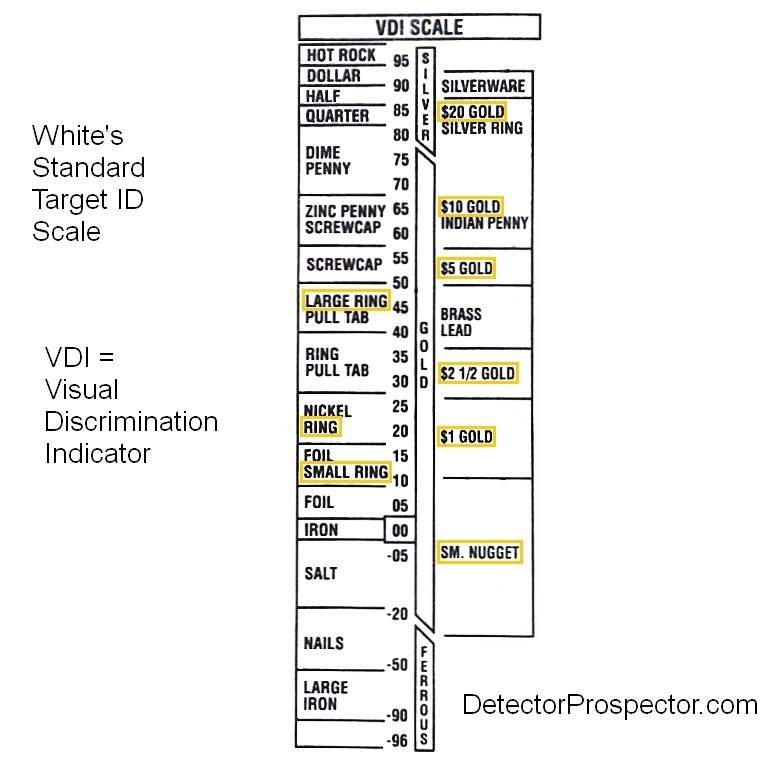Search the Community
Showing results for tags 'detector tech'.
-
Is such a thing possible? I think we still have a ways to go to get the optimum gold nugget detector. Why is it that 2 or even 3 detectors might be needed if you want to succeed? Well, you need discrimination on a lot of sites due to ferrous trash - as of today, that means you need a VLF. Unless you have a GPZ, you probably need both a GPX and an SDC to cover the spectrum of tiny shallow to deep large nuggets. VLF's can discriminate but mineralization kills their depth in many areas. GPX machines can do most of it, but don't discriminate (much) and force the operator to choose between several very different set-ups (Each with its own set of trade-offs) depending on conditions of ground and likely targets. SDC kills on small gold and is easy to use but can't discriminate and is depth limited. Even the GPZ, for all it's depth and versitility is not easy to master and costs many ounces of gold. Can a new technical approach give us a detector which deals with all these issues at once? What would this miracle detector have to do? Ease of use - It would have to be "turn on and go". Mineralization - it would have to deal,with the most highly mineralized ground - without use of adjustment and without danger of "tuning out" small targets. Sensitivity - It would have to have sensitivity to small gold at least equal to the best current VLF detectors. Depth - it doesn't have to equal the GPZ or even GPX in raw depth, but it would have to deliver more depth than the SDC - and equal the depth of the best VLF's - and do so in any ground. Will those of us who are over 60 ever see such a "Wunderwaffe"? ---- I have my hopes. What would you pay for such a machine?
-
Just curious as to whether a gold detector can detect through several inches of bedrock?
-
Has anyone here ever made their own gold detector from scratch or a kit? Any recommendations?
-
Just thought I'd start a new topic to get some discussion going. There seems to be more detectors on the market then ever. Yes a lot are variations on the same thing, but there are a few unique models such as GPZ7000, SDC2300, Gold Racer, Deus, etc. So what detector in your mind doesn't exist? Could a certain manufacturer mangle together a few of their features/patents and build something unique? Just curious
-
Due to many injuries, operations, fusions etc, I went to a pain clinic to check out my options as the pills are helping less and less. They suggested a Spinal cord implant that sends electro magnetic signals to confuse the pain that is occurring. Device can be adjusted as to strength and duration of the impulses. My question to the Dr was would it interfere with a metal detector? He said he didn`t know but would try to find out from the manufacturer. If it does it is not an option for me as I love detecting and will carry on as I do now. Anyone out there who has experience with these things? Thanks, Rege
-
The GPZ clearly represents something truly new in terms of gold detectors. It has already had a very strong effect on the pricing of Minelabs GPX series. What do you suppose would be the likely effect of some new technology detector which could discriminate as well as a current VLF machines and handle ground mineralization, hot rocks, etc. as well as the best of the PI machines and the GPZ? - Oh yes, and if it sold for a "street price" of $1500? would my "dream machine" eliminate PI's and the GPZ for nugget hunting - almost certianly not. Would it do stuff that none of today's detectors can do - perhaps. result - chaos. what is the likelihood of this happening? From ML - zero, for obvious reasons From some European innovator - unlikely due to lack of local demand for gold detectors. From Whites - unlikely due to current confusion and problems bringing more conventional new machines sucessfully to market. From Garrett - doubtful due to lack of any real recent technical innovation. Gosh - who is left? - Well, as Marty Robbins once wrote.... " out near the West Texas town of El Paso… " P.S. My own speculations only - as Click and Clack use to say "Unencumbered by the thought process".
-
USPTO Patent Application 20160041292 , Discrimination method of a metal detector. http://www.freshpatents.com/-dt20160211ptan20160041292.php "In particular, the present invention is a discrimination method that is insensitive to the signals from both resistive and reactive signal components from the soil. It was discovered for the purpose of the present invention that the presence of resistive signal components from the soil may be confused with resistive signal components from metallic targets, and thus identifying the time constant spectrum of the metallic target yields in unsatisfactory results in the presence of substantial resistive signal components from the soil. The discrimination method offered by the present invention is insensitive to both resistive and reactive signal components from the soil, which may also include a component due to a substantially uniform conducting half-space (such as a saline soil)." and "One advantage is that it gives more information about the target, and therefore it confers a greater discrimination capacity. For instance, two different targets may have the same one-component approximated time constant spectrum, but they have different two-component approximated time constant spectra. Therefore, using a two component approximated time constant spectrum may allow these two targets to he distinguished from each other." Date. Minelab Electronics Pty Limited patents. 02/11/16 Discrimination a metal detector 08/06/15 Signal processing technique for a metal detector 06/18/15 Metal detector 05/28/15 Metal detector 02/05/15 Method for detecting fast time constant targets using a metal detector 11/14/13 Support arrangement for an implement 10/24/13 Communication between a sensor and a processing unit of a metal detector 09/12/13 Method for displaying metal detection information 06/20/13 Transmit signal of a metal detector 06/13/13 Method for separating target signals from unwanted signals in a metal detector 03/07/13 Metal detector sensor head 06/14/12 Metal detector with at least one transmit/receive switch 09/29/11 Metal detector sensor head 11/11/10 Metal detector with improved magnetic response application 06/17/10 Rectangular-wave transmitting metal detector 06/17/10 Metal detector for salt soils 06/10/10 Constant current metal detector with driven transmit coil 12/24/09 Real-time rectangular-wave transmitting metal detector platform with user selectable transmission and reception properties 12/24/09 Multi-frequency transmitter for a metal detector
-
Hi Steve Just wondering if there is any new news on the Fisher rumors that were being talked about 6 months or so ago. I.e. multi frequency units. Pi units, etc. Anyone feel free to chime in.
-
You also get to see the new GPZ 19 coil being tested. There is explanatory text to accompany the video at http://www.minelab.com/usa/go-minelabbing/treasure-talk/in-the-ground-is-where-detecting-really-counts
-
Hi everyone, I hope someone can help me in understanding this. In all the forums we are told "If you go for gold you need to dig it all". And it says that – depending on ground conditions and depth plus surrounding targets – you may never be sure if it is aluminum or gold catching your detectors attention. IF this is true, why should anyone invest in gear like a Minelab CTX 3030 (which is what I am about to do...). Why not a simple Garrett AT PRO.... and why not a PI machine? I am aware of higher freqs = better for gold, lower freqs = more depth. And I am aware that every product has it's special strengths. But this does not answer the blunt question for me of why investing in fantastic ID capabilities if it's not worth it in practice. Thanks much for your piece of advice!
-
I really wanted to Make a detector test Garden in my yard. My first goal was to remove anything that would make a detector beep in a small area of my yard. I had just bought a Apex pick with the 3 magnets so I though that would be perfect for clearing the yard. However I dug only 2 shallow holes and found my yard is full of small iron rocks/pebbles as I pulled half a pocket full of pebbles from those 2 shallow holes. So thinking now I will have to do something different. Maybe buy some bags of dirt at the local Walmart Apex pick iron 2.html
-
A detector should have individual character and a distinguishing trait or quality. Isn't this why we buy that detector ? When you have a detector company that makes their product under one name you find what I said more true. Then other companies may have one name but they sell their products under different brand names of times past. I'm not saying it is not a good product they have. The trouble that comes into play is when they have the same father they start to look alike.Just by association and being conceive by the same person they all are going to be effected. If you go look at detectors that come out under different names but made by the same company you will see what I'm taking about. Oh it don't jump out and bite you but makes you think your seeing double. I don't care if it's the inner working are the skin on the outside it drift from one to the other. Okay I open this can of worms and now I'd like to hear from you on the above subject. Chuck
-
Just found this on the web: http://md-hunter.com/garrett-at-concept-new-2016-or-a-fake/ Looks interesting.
-
What's in the ultimate gold detector? I got to see a little bit of everything on my trip from the heaviest, most complicated to the light and simple. I'm a novice, maybe because of that I like simple. Knobs instead of menus. Light. Powerful. Long battery life. For fancy stuff like GPS I can use my phone. Iron ID would be nice. What's your idea of the best gold detector?
-
This is purely my perception but when I look at the market as a whole today there are only two companies that seem to produce machines that innovate - Minelab and XP with the Deus. Everyone else just keeps rehashing the 1990s over and over again. Take away single frequency VLF detectors and non-ground balancing PI detectors from current lineups and look at what is left to get the real picture. First Texas - Fisher CZ3D and CZ21, multi-frequency 5 kHz and 15 kHz Garrett - ATX, multi-period ground balancing PI Tesoro - Nothing White's - V3i & VX3, multi or selectable frequency 2.5, 7.5, and 22.5 kHz; Beachhunter ID, multi frequency 3 kHz and 15 kHz; TDI, single channel ground balancing PI XP - Deus, selectable frequency 4, 8, 12, and 18 kHz Minelab - GPZ 7000, Zero Voltage Technology GPX 5000, multi-period ground balancing PI with dual voltage technology GPX 4500, multi-period ground balancing PI with dual voltage technology SDC 2300, multi-period fast ground balancing PI Eureka Gold, selectable frequency 6.4, 20, and 60 kHz X-Terra 705, 505, 305 - selectable frequency 3, 7.5, and 18.75 kHz CTX 3030, multi-frequency E-TRAC, multi-frequency Safari, multi-frequency Excalibur, multi-frequency It is even worse when you consider that the First Texas and White's offerings are all over ten years old. You can sum new tech up in the last decade as Minelab, Garrett with the ATX, and XP with the Deus.
-
Here is a photo with some gold nuggets from Alaska, Australia, and California that I tested recently to show how VDI (visual display indicator) numbers vary dramatically with size, shape, and purity. Metal detectors do not know what metal is being detected. The target id number is based first on the conductivity of the item and also by the size of the item. Low conductive targets have low numbers, but the larger they are the higher the numbers go. Silver is the best conductor with gold being moderately conductive by comparison. Small gold items read very low, in the foil range, but the larger the nugget, the higher the numbers will go. Oddly enough adding silver to gold causes the conductivity to drop dramatically instead of adding to it. Pure metals are far better conductors than alloys. That being the case the Alaska gold has much lower conductivity than the Aussie or California gold. I have always used a U.S. nickel as a surrogate for about a 1/4 ounce gold nugget, a flattened nugget of that weight being close to a nickel in physical size. Part of this little study is to show how close to reality or not that may be, or any test items like lead or aluminum. I do not have much in the way of “normal” metal detectors these days. The closest I have right now is a White’s DFX which reads a nickel as 22 VDI, dime 78, and quarter 84. The White's VDI range is close to being a standard, with negative numbers relating to ground minerals and ferrous items, positive number non-ferrous. The range is from -95 to +95 with non-ferrous items falling between 1 and 95. The photo shows tests I just did on a variety of gold nuggets from Alaska, Australia, and California. The Australia gold is the purest, probably around 95% or better. The California is around 90% plus. The Alaska gold is much lower purity, closer to 80 – 85% average. You can see the purity differences in the color - pure gold is a very rich gold color, less pure gold much paler in appearance. Click for larger version.... Gold nugget target id numbers A few things become immediately obvious. Larger size means higher VDI numbers. However, purity appears to be even more important. Shape, thickness, and solidity all matter – skin effects? Smooth solid masses read much higher than nuggets with pitted surfaces. All weights are in grams except a couple larger nuggets which are Troy ounces (ozt). There are 15.43 grains to a gram. 31.103 grams per Troy ounce. In general in all three locales you can say that nuggets under 2 grams are going to read in the foil range. As nugget size increases however huge disparities are obvious due to purity, with all but the largest Alaska gold reading at much lower VDI ranges, and Australia gold very high numbers. There are some odd ones that prove the situation. The Alaska 29.82 gram nugget is just under one ounce, but VDI 21, almost an exact nickel reading. This is because this nugget is probably 75% - 80% gold. You can see the color difference compared to the Australian gold next to it. It also is deeply pitted. The 4.93 gram nugget directly under it is solid and smooth and about 85% pure and so has a VDI number double what you see in the much larger nugget. The Alaska 15.19 gram is round and solid but has quartz mixed with it, maybe 80% gold in metallic portion, only 12 VDI. The 1.25 oz Alaska in lower right has a lot of quartz and metallic portion is maybe 75% gold, so only 28 VDI. But get big enough, and at 6.52 ounces, 85% gold, solid and smooth, you get a reading up in half dollar 90 VDI range. For California gold I am guessing that at about 3 grams you get a nickel reading but in Australia it might be closer to 1.5 grams, and in Alaska closer to ½ ounce. Bottom line? The nugget size to get a U.S. nickel reading is all over the map from roughly 3 grams to 15 grams but can go up to nearly an ounce for nuggets of low purity with included quartz and pitted surfaces. Saying a U.S. nickel is roughly equivalent to a 1/4 oz nugget can be true and is probably as close as you will get to some sort of average, but reality is the range of nuggets that have a VDI the same as a nickel is pretty surprising. The final zinger is that these are air tests. Ground minerals will change the numbers, typically pulling them down. The worse the ground mineralization, the lower the numbers will shift. There are a few lessons here. The first being that if you know nothing about the gold you are chasing you need to dig all targets or at a minimum all non-ferrous targets. However, if you do have a target id detector and get to know the gold in your location well, you can cherry pick with some degree of accuracy. The number one factor really is size because large nuggets are very rare. Certain areas despite wishful thinking simply do not produce large gold. If you know for a fact all the gold ever found in an area is in small gram size nuggets and even smaller, you can figure high VDI numbers are probably shell casings or some other undesired target. Further, in places like Alaska with low purity gold (not all of it - Alaska is a big place) then low VDI numbers will be the norm. The numbers speak for themselves however and you can draw whatever conclusions you want. I have to admit that while I know all this intellectually from years of detecting to see it laid out clearly in a simple photo really drives the lesson home. It took rounding up some Australia gold and California gold to really make it a good comparison. To further illustrate that gold as a rough rule boils down to "the larger the gold, the higher the target id number" here is the standard White's scale as printed on several top end metal detector control boxes. It shows where gold coins, gold rings, and gold nuggets generally fall on the White's -95 to +95 scale where negative numbers are normally ferrous. Pay extreme attention to the fact that White's says small gold can fall as low as -20 on their scale - deep into the ferrous range. At the other extreme a $20 gold coin may read as high as a silver dime or quarter. The gold range covers the majority of the metal detector target id scale. White's Electronics standard target id scale -95 to +95
-
Meet The Metal Detectives - Inside Engineering at Minelab Electronics A new video showing Minelabs new engineering facility and meeting some of the people that work there. Check out the blurred portions obscuring secret product developments! Amazing engineering staff at Minelab - I consider myself fortunate to have communicated with and even met a few of the people that work there. A few more details about the making of the video at Minelab's Treasure Talk Blog
-
I have often wondered about the difference in these to metals because we often use lead to test machines or coils and it seems that the Two are quite far apart, It works out that lead is 41% lighter than Gold when compared to A 1 cubic foot Block of Gold to a cubic foot of lead, So if a person uses a 0.05 gram piece of lead to test the depth of a coil it would be 41% larger than an equal size in weight in Gold . Giving you a false example of real world testing This topic has come up before on other forums where people have just compared the two signals saying that lead hits louder but that is not the case because after doing the maths the reason it is louder is because it is that much bigger as in 1.6992 times heavier because one cubic cm of lead weighs 11.37 grams and one cubic cm of Gold weighs 19.32, So when you find an 0.03 gram piece of Gold and you want to simulate finding such a small piece then the piece of lead you need should weigh 0.0176 grams and an 0.05 gm of Gold is equal in size to 0.0294 gram piece of Lead or rounded off at (0.03 grams). Adding to this a cube of Gold that measure 14" square would weigh about One Ton Cubic foot of 24c pure Gold=1204 lbs/cf > (1) Cubic foot of Rolled Lead= 711 lbs/cf A difference of 493 pounds in a 12 inch x 12 inch x 12 inch cube. Anyway this is just something to bare in mind when a person is trying to test out machines and coils when you do not have access to tiny nuggets. John
-
Ok....it is almost June 2016. It seems so far this year we have seen some entry level detectors and an attempt at rehashing previously released detectors. Just trying to be real here, but we have not seen anything really innovative since the Minelab 7000....and that was nearly a year and a half ago. Now I know, VLF technology has probable reached its limits, and even PI's are nothing new. However, I would have at least thought that one of the major manufactures would have thrown us a bone or two. WHERE ARE ALL THE NEW DETECTORS ??
-
My recent experiences with new model metal detectors has convinced me of two things. First, I want every new model I might consider going forward to have built in wireless headphone capability. It eliminates the issues surrounding where to place a headphone connection on the metal detector itself, and also eliminates the possibility of a cord failure. Stress on the cord and eventual breakage is the number one reason headphones fail. Headphones, if included or optional, would be best if they had the ability to go wireless or use an optional cord, in case the headphone battery gives out in the middle of a hunt. Second, high end new models should have an ability to have the firmware updated at home by the owner. It has become nearly normal for there to be firmware updates, even multiple updates, in the first year after a new detector is released. I am not talking about getting new features for free, although that would be nice. I am talking about it becoming apparent that a bug exists or something was overlooked, requiring an update to the firmware. Nobody should have to go through time and expense to have to return a metal detector to the factory to get a firmware bug fix. There are just too many new detectors becoming available these days, and I decided I need to draw a line on certain features to help eliminate the majority that are just variations on what we already have. Right now the market is flooded with 13 - 19 kHz single frequency detectors and more arriving every month it seems. Yet models with built in wireless headphone capability are almost non-existent. Given that basic single frequency VLF tech is maxed out, it only stands to reason that manufacturers need to be looking hard at ergonomics and extra features like wireless capability to differentiate themselves from everyone else. It is after all the 21st century. Maybe I can't get my flying car yet, but asking for these two features in new detectors is not asking too much. My current core units: Garrett ATX - N/A Makro Gold Racer - Includes wireless headphone capability as an option Minelab CTX 3030 - Includes both wireless headphone and firmware update capability Minelab GPZ 7000 - Includes both wireless headphone and firmware update capability White's DFX - N/A XP Deus - Includes both wireless headphone and firmware update capability
-
I've seen metal detectors in stores and shows for thirty years, but am only now thinking about them like I'll own one within a few weeks. Maybe this is too sci-fi of an idea, but given the popularity of the wireless XP Deus (the name! god and an outdated operating system), and the ubiquity of smart phones, when will we see a mfr put the computing power of a smart phone to work? Put a digitizer in the coil, broadcast the signal to the phone, where the processing happens, perhaps with highly customizable features (user programmable?), then bluetooth to send the audio to headphones... Graphics happen on the phone from its secure position on the handle... Too crazy? Too simplistic?
-
First, I want to say this is one of the best forums I have ever seen. Steve has put together a GREAT website. The knowledge base on the forum is just phenomenal. I have learned so so much more about metal detectors from all of you. So let me explain assumed. I assumed: White's and Garret were the best metal detectors. Carl Moreland was still working for White's Metal detectors were 10 years behind technology of today. (just my thought) After making the assumptions, I realized how wrong I was thanks to this forum. I realized White' and Garrett have been a sleep. Carl Moreland either quit or was fired. White's and Garrett detector are whats 10 behind. When I got back into metal detecting last year. I was looking for a new machine. I looked at White's and Garrett with the assumptions. I thought about building my own detector. So I read Carl Moreland's book. (Great book) I realized that it would take me 2 to 5 years to develop my own detector. So I scrapped this idea. I could not understand why White's or Garrett had not built a detector with what I expected. I thought that with today's technology there should be a sweep frequency oscillator for the coil-s and an easy to read display. That being said, White's closest model was the V3i. Garrett had nothing. I quickly realized that I needed to look at everything. Because of the forum, I found Minelab was being discussed. When I found the Minelad Safari, I quickly realized it had what I was thinking of building. I don't like their LCD display. It does not look clear a crisp to me. However the machine looks promising. Then I looked at the E-track and CTX-3030. These also look to be very promising machines. Just the price is higher that I want to pay for a -2 times a month hobby. I really wish the best for White's and Garrett. They have their work cut out for them. I want to thank John, Chuck, Tom and Terry and many others I do not know their names for the knowledge your provided and a special thank you to Steve H for his superior knowledge and the wonderful website he has provided.
-
I do wonder what is up at White's Electronics. They have not put out a new detector platform since the V3i in 2009. Just rehashes of the MXT mostly. Yet they have been extremely busy on the research front, with the patent issued on half sine technology earlier this year http://www.detectorprospector.com/forum/topic/118-half-sine-metal-detector-technology-hybrid-induction-balance-pulse-induction-metal-detector/ And now a new patent for a constant current metal detector: http://www.google.com/patents/US8878515 United States Patent 8,878,515 Earle November 4, 2014 Inventors: Earle; John L. (Sweet Home, OR) Assignee: White's Electronics, Inc. (Sweet Home, OR) Family ID: 51798186 Appl. No.: 13/235,916 Filed: September 19, 2011 SUMMARY OF THE INVENTION The new invention provides better target object characterization and identification while eliminating ground mineralization detection. A constant current in the energizing coil establishes a constant magnetic field that goes from zero to a strong, but constant, field very rapidly, as in less than 10 microseconds. Target objects such as coins and other eddy current objects have an energizing time constant usually exceeding 10 microseconds, wherein the eddy currents accelerate until field equilibrium is reached in the target object. A constant current or constant magnetic field does not produce a significant signal in a receive coil after the transition from zero to constant current from ground mineralization permeability (powdered iron or ferrite equivalent). Target object eddy currents do produce a signal of varying amplitude throughout the constant current period, depending upon eddy current charging time or inductance of the object, usually not a simple exponential due to configuration of the target object. i.e., diameter, thickness, conductivity, etc. It will be interesting to see if these patents result in any actual product. People often make the mistake of thinking a patent means something is ready to hit the shelves and the truth is just the opposite. Patents are often filed and nothing ever comes of it. Or it gets licensed to others, who actually produce the goods. Who knows what is going on in this case, but White's is obviously still attempting to move the technology forward. I hope the best for them as they are an old name in the business and a great bunch of people. What makes this doubly interesting is Minelab also has patents in the works on constant current technology. http://www.detectorprospector.com/forum/topic/311-minelab-bruce-candy-new-patent/?p=2291 The Minelab work is an application for patent that has been in progress since 2009. This White's deal is an actual patent granted. Is there conflict here? Obviously with these two big names at work on the same thing something is up. Sad story is I am not well versed enough in the technology end of things to truly understand how this may actually improve metal detectors for the end user. Other than what it says up above - better discrimination while eliminating the ground. How much better is better?


